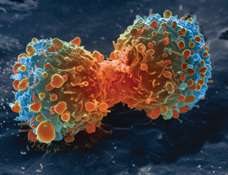Source: VIB (The Flanders Institute For Biotechnology) Nov 19, 2018 7 years, 1 week, 3 days, 8 minutes ago
Mutations in RAS proteins initiate many of the most aggressive tumors, and the search for pharmacological inhibitors of these proteins has become a priority in the
battle against cancer. Michail Steklov, Francesca Baietti, and colleagues from the Anna Sablina lab (VIB-KU Leuven Center for Cancer Biology) identified LZTR1 as an evolutionarily conserved component of the RAS pathway.
Multiple genetic studies overwhelmingly point out for the role of LZTR1 in a wide range of human disorders, such as Noonan Syndrome (a genetic disease), liver cancer, childhood cancer, and Schwannoma, a benign tumor that affects nerves. The researchers found that LZTR1 contributes to human diseases by acting as a part of the ubiquitin ligase complex that mediates conjugation of ubiquitin to RAS proteins. This conjugation reduces RAS recruitment to the membrane and thus its activation and downstream signalling.
Prof. Anna Sablina (VIB-KU Leuven): "Despite of constant and exhaustive efforts to characterize RAS proteins, LZTR1 is the first novel RAS regulator, implicated in human diseases, that has been identified since years. Of course, this will be not possible without a help of our collaborators from UZ Leuven, VIB-UGent Medical Biotechnology Center, National Cancer Institute at Frederick, and University of Alabama. We hope that the discovery of this alternative mechanism of RAS regulation will lead toward novel therapeutic approaches for RAS-driven diseases."
Reference: M. Steklov et al. Mutations in LZTR1 drive human disease by dysregulating RAS ubiquitination, Science (2018). DOI: 10.1126/science.aap7607
About RAS:
RAS proteins are binary switches, cycling between ON and OFF states during signal transduction. These switches are normally tightly controlled, but in RAS-related diseases, such as cancer, RASopathies, and many psychiatric disorders, mutations in the RAS genes or their regulators render RAS proteins persistently active. The structural basis of the switch and many of the pathways that RAS controls are well known, but the precise mechanisms by which RAS proteins function are less clear. All RAS biology occurs in membranes: a precise understanding of RAS’ interaction with membranes is essential to understand RAS action and to intervene in RAS-driven diseases.
RAS proteins play a causal role in human cancer: this has been recognized for many years and has inspired multiple attempts to find RAS inhibitors. Mutations in RAS regulators, such as neurofibromin and SPRED1, also make significant contributions to cancer.
“RASopathies,” a collection of developmental conditions caused by germline mutations that activate RAS/MAPK signaling, affect more than
12 million individuals in the world. Abnormal RAS activity may also play a significant role in autism and other neurological disorders.
RAS proteins are binary molecular switches that cycle between active guanosine triphosphate (GTP)-bound and inactive guanosine diphosphate (GDP)-bound states. This switch mechanism has been highly conserved among GDP/GTP binding proteins as diverse as bacterial elongation factors, heterotrimeric G-proteins
, and a myriad of small GTPases with diverse biological functions. The conversion from stable, inactive GDP-bound forms to the active GTP-bound form is stimulated by guanine nucleotide exchange-factors (GEFs). Conversion back to the inactive form is mediated by GTPase-activating proteins (GAPs) . GEFs and GAPs are large, multi-domain proteins capable of an astonishing variety of interactions with other proteins, lipids, and regulatory molecules that control levels of active and inactive RAS
